|
Art and Existentialism
© Robert
Foddering 1998
Part I: Art and Existentialism
Aims
Introduction
Existentialism
Art and Existentialism
Investigative Problems
Tate :Paris Post War: Art and Existentialism
1945-55
The Artists
Commonality
Further Study
Giacometti
Part II: Giacometti and
Existentialism
Introduction
Giacometti
Giacometti’s Concerns
Giacometti’s Work
Giacometti and Existentialism
Part
III: Art and Perception- Existentialism?
Introduction
Existentialism and Contemporary
Influence
Cezanne to Arikha- Existential Perception
Not Limited To Existentialism
Existentialism and Perception
Conclusion
Bibliography
List Of illustrations
|
Part I - Art and Existentialism |
“What expresses
itself in language,
we cannot express
by means of a language. What can be shown, cannot be
said.”
Ludwig Wittgenstein,
Tractatus
Part I - ART
AND EXISTENTIALISM
Aims
Existentialism holds
a personal interest for me, especially in its attempts
to explain mans existence within the world. I feel that
existentialism and its expression within the arts, reflects
closely with the interests I have developed in my personal
work and perhaps its concerns are still relevant to
all artists operating in contemporary society.
Throughout this dissertation
I aim to investigate the commonality between the philosophy
of existentialism and the production of the arts. This
will lead to an investigation into the method of genuinely
representing existence within art. There should be investigations
into the artist and their work. Areas that delve into
the relationship between a philosophy and the arts and
how genuine that relationship is. This allows us to
investigate how deeply society, contemporary thinking
and mood affect individual artists and whether a philosophy
can truly be represented or used as a motivation for
production within the arts.
Introduction
Existentialism was
a philosophy that developed during the occupation and
the French post-war period of 1945. It was a time of
great change, the aftermath and atrocities of the Second
World War left Europe’s, and perhaps the entire
world’s population re-evaluating the meaning of
their existence. At the same time being confronted by
nuclear threat, death and mass destruction.
“World war
two constituted a natural disaster, in so far as it
tore asunder the seamless web of signs that constitutes
modern civilization. Philosophy and art should simply
be about the possible actions and decisions a human
being who is stripped of his role can take.” 1
In the post-war period
existentialism filtered through to all areas of main
line contemporary thinking, and a common concern for
explaining the place of man within the sphere of things
developed. Jean-Paul Sartre (the philosophy’s
greatest exponent) took the texts of Soren Kierkergaard
and Martin Heidegger and re-evaluated and added to a
contemporary philosophy of existentialism. Other existentialists
include Genet, Camus, Beckett, Ponge, Ponty and Simone
de Beauvoir (partner of Sartre.) Beauvoir defined existentialism’s
appeal to the French Post-war society:
“The masses
had lost their faith in peace, in progress, they had
discovered history in its most terrible form, they needed
an ideology which would include such relationships without
forcing them to jettison their old excuses. Existentialism
forced them to accept their transitory condition without
renouncing a certain absolute, to face horror and absurdity
whilst still retaining their human dignity, to preserve
their individuality.” 2
The post war climate
introduced a new and devastating dimension for the individual
and world politics:
”The first
half of the century ended at Hiroshima, the second half
began with gravest doubts about the human species being
around to record its end.”3
The two halves of the century also
mirrored a division in the French arts. Before the war
surrealism was the popular mode of expression, but the
occupation soon changed this, after the liberation,
the call to begin again was embodied both in existential
literature and the arts. This call perhaps overpowered
the continuation of previous debates. It was a new beginning
with
“Everything essential
still left to be defined.” 4
Existentialism
Existentialism is a
complex philosophy; in its time it was perhaps
“A climate
of opinion rather than a coherent philosophy.”
5
This was largely due
to the many different facets of the philosophy that
refused definition in a brief text. Sartre’s first
existential text “Being and Nothingness”
was published in 1943 and it was read for a decade after
this date.
“For those
dauntless enough to take on the work, a healthy amount
of time was needed to wrestle the beast into submission
and digest something of what is purported to offer in
the way of contemporary wisdom.” 6
This excerpt describes
the complexity of coming to terms with existentialism
and it questions the true depth any individual can achieve
in exploring existentialism through the use of a text.
Sartre followed the
650-page text with a discussion entitled “Existentialism
and Humanism” that perhaps defined the text in
an easier mode of discussion. It is essential at this
point to tackle some of the key points of existentialism,
not only to get a flavour of the philosophy, but so
that we can also evaluate the extent of which existentialism
influenced the artists we shall study.
Sartre’s existentialism
was devoid of religion and god. His explanation (Or
replacement) for the absence of a higher creator was
the term
“Existence
precedes essence.” 7
Sartre made no attempt
to explain the meaning of man’s existence, however
he provided an alternate solution to man’s questioning
of the origin of his creation. The post war period was
a time of evaluation in every mode of belief. For many,
religion did not encompass the answers society needed
considering such atrocities. The importance of political
alignment became crucial. Existentialism’s ideas
about the self-governing individual compared directly
to the socialist ideas of communism. During the post
war era Sartre became more and more aligned to the communist
ideal, this questioned his motives contained within
his texts, it also puts a shadow of doubt on his relation
to art:
“Sartre’s
alignment with the French communist party involved disturbing
silences in regard to previous editorial exposes of
Soviet labour camps and the communist party position
on art, the strict social realist campaign.” 8
The centre of Sartre’s
existentialism lay in the phrase “Existence precedes
essence,” it means that we exist before we are
consciously aware that we are alive. We then achieve
the realisation that we exist and define ourselves subsequently,
perhaps searching for the meaning of our existence at
this point, and falling short of an adequate explanation.
Sartre described it
as:
“Man first
exists, encounters himself then surges up in the world
and defines himself afterward.” 9
This countered the existence
of god, the heart of Sartre’s argument lies in
man’s need for an explanation to existence that
was consumed but not explained by the belief in god.
Sartre explained there is not a higher entity that has
created us, as we would create an object, we just simply
exist then need to explain that existence. This assumption
left society without the constraining elements of religion
and damnation. Would it be a place without positive
constraint, morality and a law-abiding civilisation?
Sartre’s answer to this was
“If existence
is prior to essence, then existentialism puts every
man in possession of himself and places the entire responsibility
for his existence upon his shoulders. He is not just
responsible for himself, but responsible for all men.”
10
This notion attempted
to place the concept of man being totally responsible
for himself and controlling his future with constant
regard to the future of society. This was perhaps a
calculated thought (And perhaps idealistic) considering
the consuming guilt of the war, if every man took responsibility
for their actions, instead of answering to a higher
command, would there have even been a war? With this
responsibility one should fashion ones own existence,
as you believe man ought to be, making a commitment
on behalf of mankind.
“There is
no reality except in action. Man is nothing else but
what he purposes, he exists only in so far as he realises
himself, he is therefore nothing else but the sum of
his actions, nothing else but what his life is.”
11
This reinforces Sartre’s
notion of man being totally responsible for himself.
If man does not attempt to achieve the things that he
should, then there is no proof of his existence and
he has failed to give his individual life meaning, which
is every mans need and desire.
Art and Existentialism
How do these points
of existentialism relate so closely to the production
of the arts? If we summarise the main points of existentialism
in relation to the practice of the artist, we shall
see that there is quite a close relationship between
the two.
“Man’s
consciousness is subjective and can never become aware
of itself objectively, except through the gaze of the
‘Other’. If other people function as mirrors,
so too can the work of art” 12
This is Sartre’s
position on the use of the artwork in existential terms.
He has placed great importance to the practical ‘use’
of art to society. However, the broader relationship
to existentialism is not as simple.
It puts every man in
control of his life, shaping himself as he wishes society
to be, the artist standing before a blank canvas has
the opportunity to completely control a portion of the
output of his existence more than any other individual.
The objects he creates are contributions to the culture
of society, and with his art he is attempting to shape
society in the fashion he sees fit. “There is
no reality except in action”, speaks directly
to the artist, assuring him that unless you create what
you should there is no justification to your existence.
Existentialism’s relation to art from these terms
seems to be through the definitive use of art to benefit
society. It is art’s benefit to existentialism
that raises doubts about genuine motives.
The individual is nothing
but the sum of his actions:
“This does
not imply that an artist is to be judged solely by his
works of art, for a thousand other things contribute
no less to his definition as a man.” 13
Sartre says that man
is judged by everything that he does not just his individual
actions. However, it’s Sartre’s use of the
artist as an example of the strongest form of an individual
representing their actions that depicts the artist in
such a strong light in comparison to the ideology of
existentialism.
“Does anyone
ever reproach an artist when he paints a picture for
not following rules a priori? As everyone knows there
is no predefined picture for him to make.” 14
This quote shows us
how Sartre related the artist to the essence of existential
ideals- “existence precedes essence.”
These comments could be seen as
pure speculation on the relationship of the philosophy
to the arts. Nevertheless it was Heidegger who defined
a philosophical relationship to the arts that Sartre
appropriated. This excerpt does not specifically talk
about the production of the arts as proof of authentic
existence. However when you read the text it seems that
the ideology of the artist fits perfectly into Heidegger’s
theory of authentic existence:
“The root of man’s
anxieties is his intensity to feel and know that he
exists... and although his fate is to die, he can triumph
over his anguish that the whole is meaningless, by inventing
purposes and projects, which will put meaning upon himself
and upon the world of objects: all meaningless otherwise
and in themselves. There is no reason why man should
do this apart from gaining the authentic knowledge that
he exists: but this is exactly his desire. Not many
are capable of thus authenticating their existence.”
15
Kierkergaard (who also influenced
Sartre in terms of existential art) commented on the
relationship of art and existence. He thought that anyone
who was not either religious or an artist must have
been a fool. It is the comparison between religion and
art that highlights the importance of art. Religion
allows the individual no concern about the meaning of
existence and the other is perhaps concerned with illustrating
our existence consciously or unconsciously, thus providing
a focus.
The relationship of art to existentialism
could be discussed in a purely theoretical term for
the entire length of this dissertation. It is unfortunate
there is not space for an in-depth review of the role
art plays purely in a theoretical sense. The discussion
of existentialism above must be remembered to be very
limited, not only in the depth of the investigation,
but also in the date the text was written as existentialism
evolved through the following decade paticularly in
its political stance. I have tried to analysed texts
very close to the post war period in the hope of corresponding
the date of the works to the depth of existentialism,
I think I have superficially proved that a relationship
exists between existentialism and the arts.
History has been quick to associate
this period of work with the philosophy of existentialism
and it is only through the following investigation that
we shall find out if history is justified.
Investigative Problems
The following investigation presents
many problems that have to be broken down before we
can genuinely make assumptions about the artists relation
to existentialism.
How correct is it to call an artist
an existential artist?
It is difficult to distinguish, in
light of the French post war mood, what was promotion
of fashionable existentialism and what was perhaps the
more genuine embodiment of an individual's feeling or
the mood of the genre.
It is important to point out at
this stage that calling an artist existential is insensitive
to the artists concerns. It is perhaps a statement that
fails to consider all aspects of an artist’s work;
I have primarily tried to ascertain whether some form
of relationship did exist within the artist’s
work. It is only through this detailed examination that
we shall eventually understand the extent to which existentialism
affected the artists.
Is it correct to call the artists
work representations of the existential philosophy?
For example: If you produce art that
abides to the ideals of existentialism, you are not
embodying true feelings about yourself. You are only
producing work that promotes a philosophy; in consciously
representing that philosophy it would be difficult to
encapsulate more than one philosophical ideal genuinely.
Each work would be singular in its content and one dimensional
as its objective would not be a truthful concern of
the artist. It would merely be a weak representation
of the existential philosophy and a weak artwork, neither
genuine in either genre. Ths only art we could define,
as being existential without concern for pigeon holing
the artist, would be art that used existentialism as
its conscious generator for production.
A specific example would be to promote
one aspect of the existential philosophy in a work of
art, e.g. the isolation of man and his anguish because
of this isolation. If I represented this notion it would
show us how isolated man was within the world. However,
if I tried to show how isolated I was, I would be dealing
with true feelings that attain themselves to me, yet
also refer to existentialism at the same time, this
is the more genuine relationship. These feelings can
be used as reflections of existentialism, but not representations
of the philosophy. If this occurs the artist has made
a genuine reflection of that philosophy, albeit in hindsight.
16
There are many artists who I think
have chosen the easier path of depicting existentialism
(perhaps through narrative or style) than there have
been representations of individual expression about
reality that mirrors existentialism.
Examining the artists would show
us the artists who were representing over depicting
and eventually reveal the common aspects these artists
have. The outcome of that commonality would reveal the
genuine relationship between art and existentialism.
Once we have discovered this point we can examine relationships
that are not limited to existentialism or post war Paris
and are concerned solely in the production of the arts.
First a broad investigation into
the connection between existential artists’ works
is essential to reveal the true elements of the origin
of their work that is commonly captivating. Was it the
era, the artists’ frailty, or was it existentialism
(despite my hypothesis) itself that drove these artists
to produce compositions that were so close to mirroring
human existence?
Tate: Paris Post war - Art
and Existentialism 1945-55
In 1993 the Tate gallery held an
exhibition entitled “Paris Post War- Art And Existentialism
1945-55” and it is from this exhibition that I
have chosen to investigate the artists’ link to
existentialism. Historically this exhibition brought
together a group of artists that represent a forgotten
era in the development of the French art scene.
The choice for the artists supposedly
within the exhibition was an attempt to build a more
in depth investigation on a broader exhibition at the
Barbican Centre: “Aftermath: France 1945-54.”
The reason I have chosen to use
the artists from this exhibition is due to the difficulty
in ascribing an artist to the philosophy of existentialism
and to cut down on the over long text that I would need
to justify these artists relation to existentialism.
We can never be certain of artists'
intentions; the justification for a choice of an artist
is perhaps more hearsay than fact.
Due to the length of this thesis,
the investigation into a few artists in depth would
reveal more relevant information, than an investigation
over a broad topic area, although the artists I choose
shall not be without justification. The exhibition organiser
cannot be trusted to make a truly objective decision
without the commercial worry of gaining a large enough
audience; we must examine the justification for the
inclusion of each artist before we can use them. For
example: the inclusion of Picasso within this exhibition
seems to me to be a token commercial offering, that
immediately questions the motives of the other artist's
inclusion within the exhibition. (See fig.1)
The Artists
The other artists in the Tate exhibition
are: Antonin Artaud, Jean DuBuffet, Alberto Giacometti,
Jean Fautrier, Wols, Bram van Velde, Jean Helion, Henri
Michaux, Germaine Richier and Francis Gruber. (See
fig.2)
It is in the following text that
we need to exclude the artists who do not need further
investigation into their motives. To me art has to encapsulate
more than an element of the existential philosophy to
be associated as a link, the work should deny singular
comparison to the philosophy and encompasses elements
that refused to be defined in words thus becoming an
equal to existentialism, due to the similarity generated
by a harmony of ideals.
A lot of these artists did have
a personal relationship with existentialism perhaps
directly or indirectly: They may have been involved
within the existential social scene, or may have had
a direct involvement with existentialism, but there
are questions that still remain to be answered; What
is the commonality between these artists and in terms
of representing existentialism how genuine are they?
Jean Fautrier made representations
of hostages that were based on the wartime torture and
summary executions of prisoners, which he heard every
night from his living quarters. (See fig.3) They were
seen as extraordinary in their production. The paintings
were layered very thickly without direct concern for
realism. In this way they were images never seen before,
paintings that broke down the rules of aesthetics know
at that time. However, I feel that these images and
the motifs behind representing these images can only
be superficially existential. The most prominent element
of Fautrier’s work that could be deemed existential
is his use of his medium, due to the “newness”
of the approach. The narrative within Fautrier’s
work is too specific to be concerned with a higher element
of existence within the grand sphere of things.
17
Dubuffet made scenes of urban and
domestic life in a consciously naive style. (See fig.4)
Dubuffet appears to be more consciously aware of existentialism
than Fautrier and his narratives suggest a wider representation
of existence. DuBuffet announced he was a self-confessed
convert to existentialism- the critics noticed his original
approach and linked it to the new existential literature.
Dubuffet’s work in this context appears to be
ascribed to existentialism due to its style rather than
the content and depiction of his work. Dubuffet thought
“Art should go to the roots
of mental activity, where thought is close to its birth”
18
This compares directly to the breakdown
of mans thought within existentialism. He investigated
this notion by purchasing and studying art by schizophrenic
artists and copying their naive style.
These are elements of Dubuffets work
that could be defined as concerned with existential
ideals, however I feel that an in-depth investigation
into his work would reveal more about arts relationship
to society than Dubuffets artistic relationship to existentialism.
It seems to me that he adopted the philosophy considering
the fashion of the day. If it were something that his
beliefs originally paralleled, he wouldn’t have
felt the need to announce that he had adopted the philosophy.
It seems that in having done this his work cannot be
taken as genuine representations of his own art that
reflects existentialism. There are more aspects of this
work that are concerned purely with the method of production
of art, than there are that share the concerns of existentialism.
Jean Helion’s work shows a similarity in its concerns,
it also comments on art more than existence.
Helion produced paintings that were
primarily concerned with abstraction, his pre-war work
was similar to Mondrian’s hard-edged abstraction,
and it was the change of direction in his post-war work
that caused a stir. The work consisted of abstracted
forms that were imposed on figures and it seems now
that Helion is remembered for his attacks on the conventions
of art primarily within the hierarchy of abstraction,
than for his work. (See fig.5)
His inclusion within the Tate exhibition
I think is primarily due to the paintings resonance
of the 40’s and 50’s. At first glance the
paintings’ seem to be purely aesthetic, but after
further investigation the paintings reveal a narrative
that could be associated with existential fiction. The
figures in the plays of Beckett have a particular similarity
to Helion’s figures; they both exist in mediocre
yet somewhat unusual and disturbing situations. In Helion’s
words his narratives concern themselves with
“The extraordinary within
the banal. The mystery of ordinary things.” 19
(See fig.5)
The themes occurring within Helion’s
work also relates to a depraved society, the simple
things like loaves of bread, become symbols of post
war poverty and destitution. (See fig.6)
The figures appear to be alienated and living in isolation
oblivious of each other’s existence. (See
fig.5) These narratives reflect deeply with
the social condition that existed and created existentialisms’
popularity, however there is no direct link to existentialism
outside of the similarity between these narratives.
Helion’s work was symbolist in a surreal manner
of the condition he saw existing in post-war France.
Sartre discarded the notion of surrealism as having:
“A preoccupation with the
unconscious and not the totality of man.” 20
This provides a key to Helion’s
relationship to his depiction of existence. I think
Helion was concerned with the unconscious human condition
of the post-war era, but not in the depiction of the
totality of mans’ existence that existentialism
attempted to describe. Helion does not present himself
as having a multi-layered relationship to existentialism.
Henri Michaux produced a series
of paintings in an intense period of activity after
his wife died. (See fig.7) To Michaux
his experience of pain and suffering was the key to
the production of his art.
“It is through pain and
other extreme states that the individual can most effectively
break through the protective armour of conventional
behaviour, through to intensely personal primordial
mental states.” 21
Francis Bacon commented on Michaux’s
use of mark:
“I think Michaux is a
very intelligent man and conscious man, who is aware
of exactly the situation he is in. I think that he has
made the best free marks that have ever been made, it
is more factual; it suggests more. His paintings have
always been about delayed ways of remaking the human
image, through a mark which is totally outside an illustrational
mark but yet always conveys you back to the human image.”
22
Through Michaux’s image you
experience an image or mark that as Bacon describes
as unconventional. It means nothing, yet aspects of
it revert you back to the image of human physical appearance.
It seems that Michaux’s images connect with the
ideals that existentialism is associated with. A meaningless
sphere of existence (existentialism) / meaningless marks,
(Michaux) which compares to Human existence (existentialism)
/ the human image (Michaux). I think that this similarity
exists as an equality of ideal, not due to the period,
but due to Michaux. The link between existentialism
and Michaux would certainly benefit from further investigation.
A similar artist, whom I also feel
would benefit from further investigation, is Wols. 23
But unlike other artists we have
already assessed, he did not produce his work in conscious
reference to the history of painting or any other concept;
his images were much more genuine:
“My pictures are
not a revolt against anything, in spite of misery, poverty
and the fear of becoming blind one day, I love life.”
24
(See fig.8)
In the second half of this quotation
Wols reveals his concerns with his existence. He was
an alcoholic, who died prematurely in 1951, he found
release from his life in nature:
“It made me forget about
human pretensions, invited me to turn my back on the
chaos of our goings-on, showed me eternity.” 25(See
fig.8 a] )
Wols images appear to be microscopic
structures of life seen under a microscope, or distant
planets seen from a telescope. (See fig.8 b]
) It was Sartre himself who recorded that
“Wols is seeing the Earth
with inhuman eyes, he visualises our universal horror
of being in the world.” 26
(See fig.8 c])
Sartre made comparisons between
his existential novel ‘Nausea’ and Wols’
alarm at the world. Nausea’s main character continually
writes in his diary about the changes he sees occurring
around him in the “World of objects” and
the nausea he experiences from the objects that become
increasingly alien. Wols attempt to see the world through
different eyes was almost an attempt at perceiving our
world objectively. The works are almost like the creation
of another world and existence, that is no less believable
or absurd than our existence. It is when the individual
is confronted with this fact in comparison to these
images that the question of our existence comes to the
forefront of our minds. Wols compares directly to the
existential perception of the world. He encapsulates
the existential philosophy within his work and at the
same time investigates places existentialism does not
touch.
It is this shared sensibility between
Wols and Michaux- the knowledge and expression of perceiving
the world through human eyes that is expressed more
solidly in the work of Giacometti. Giacometti does not
need to be justified as an existential artist, as he
has been unavoidably associated with existentialism
and his work has been termed as representations of “Existential
man.”
Commonality
What is the commonality between
these artist’s? Most of these artists were conciously
or unconciously responding to the effects of the war
on their way of life, although some were not consciously
doing this, like contemporary artists today are not
consciously representing the onset of the millennium,
however whatever affects society in its outlook, also
affect its individuals indirectly. I think the ascribing
of some of these artists to be existential after investigation
is incorrect, as they were responding to their environment
not the philosophy, the term existential is an easy
way of pigeon holing a group of artists that refused
to be defined within a group. Some of the artists' refuse
such a black or white decision about their involvement
to the philosophy, the true commonality between these
artists in reference to existentialism is the individuality
of approach these artists had, more than any conscious
individual representation of the philosophy.
“Non-style, has itself
become a style” 27
Some of the artists have been deemed
existential due to their chosen isolation and the affect
this had on their activity. Perhaps one of the strongest
icons within existential literature was the image of
the “outsider”. The outsider gained a visceral
view of life and society due to their isolation and
their ability to observe more objectively than the involved
individual. However when this is applied to the arts
I feel it becomes a cliché more than proof of
an individuals existential motives.
“The outsider may be an
artist, but the artist is not necessarily an outsider.”
28
Further Study
I think the artists who need further
investigation are Giacometti, Wols and Michaux. (See
fig.9) Jean Helion presents an interesting representation
of the philosophy that could be seen as more literal
interpretations, however I feel his works pale in the
comparison to the perceived world of Wols and Giacometti.
The other artists who I have discussed in this text
are perhaps artists that embodied the scene of existentialism
and may have even been worth investigating in their
relation to existentialism, however I feel that their
work was not strong enough to justify investigation,
or their work was concerned with other ideals that present
themselves more readily. These artists are: Gruber,
DuBuffet and Fautrier.
Other artists I have not even attempted
to include, I feel would take a large proportion of
this essay to justify their inclusion and due to exactly
this fact they do not present themselves as being particularly
concerned with the ideals between art and existentialism:
Artaud, Picasso, Richier and Van Velde. (Velde was linked
to existentialism more than the category I have placed
him defines; however his work denies a formal interpretation)
It is here that we meet several points that must be
assessed before we can continue to discuss the links
between existentialism and art.
Now we have found genuine artists
that reflect ideals of existentialism in their work,
we can gain a more rounded view of existentialism’s
relation to art. However, we must remember to only reflect
between the relationship of art and existentialism.
Giacometti
The painter and sculptor- Alberto
Giacometti had undeniable links within the “Existential
scene”. Sartre and Genet, who both wrote literary
works about him, embraced his work: Sartre with “The
quest for the absolute” and Genet with “The
studio of Alberto Giacometti”.
Sartre also wrote about Wols work
and it is surprising that only Sartre identified these
artists out of the eleven on an existential level. It
is perhaps the link between Wols, Giacometti and Michaux
that needs further investigation to see what shared
relationship these artists hold toward existentialism,
it is the discovery of this association that will perhaps
reveal the genuine relationship of art to existentialism
or the genuine representation of existence within art.
Is it true that because of an artist’s
personal relationship to the philosophy, the output
of their work can be called existential in a philosophical
sense? Does this involvement mean that Giacometti was
an exponent of the existential philosophy? Or was he
an artist merely representing his vision? We cannot
be sure what his objectives were which makes the involvement
of Giacometti a key relationship to the breakdown of
the artist's relationship to existentialism, or the
genuine representation of existence within art.
|
Part II - Giacometti and Existentialism |
“Why do we create?
Michaux said: ‘To
get out of the chaos’
Genet said: ‘To
be loved’
Nabakov said: ‘To
drive back the beast’ “
- From the film ‘The
sexual life of the Belgians.’
Part II - GIACOMETTI
AND EXISTENTIALISM
Introduction
In an interview with Francis Bacon,
David Sylvester talked about the tendencies that occur
when interpreting an artist’s work. In particular
Giacometti’s figures, which have been interpreted
as “existential man”, something that Giacometti
found crass. 29
Giacometti always emphasised that
his work was not concerned with existentialism, 30
however this does not mean that a relationship did not
exist: directly or indirectly.
Was Giacometti work just the representation
of existential philosophy? Or was he representing his
existence? Can Giacometti's work be used as a truthful
reflection of existentialism?
All of these points of investigation
can only be answered by looking in-depth at Giacometti’s
character, then comparing him side by side to the production
of his work and the representations that art reveals
to us. It is only through this examination that we will
discover if Giacometti is truthful to himself or existentialism,
and at the same time find out if Giacometti’s
art can be used to enlighten existentialism. Could it
be that to call Giacometti’s figures existential
was perhaps a sweeping statement, yet it contained an
element of truth?
The link between Giacometti and
existentialism can be traced back to Jean Paul Sartre.
He wrote about Giacometti in his texts as an example
of an artist authenticating their existence.
However the style of existential
art or art that defined itself as existential was a
contradiction.
“Sartre offered an implicit
call to artists to make art without preconceptions;
to define themselves.” 31
So from Sartre’s point of view,
artists should not make art about existentialism, they
should make art about their own existence, perhaps using
existentialism as a tool to unlock the representation
of existence. However this statement cannot be taken
as the literal truth,
“Sartre approaches art
with an open mind, but seeks always to fit his findings
into the philosophical scheme of things.” 32
So even though Sartre called on
artists to make work about themselves, he would still
fit their work in his texts into his philosophy, when
it was not necessarily concerned with existentialism.
It is from the discovery of this point that we understand
why the intentions of the artists of the post-war period
have become so confused with existentialism.
Giacometti
Giacometti first rose to prominence
in the 20’s it was here that he was involved within
the surrealist movement. However it was during the late
30’s he became convinced that surrealism was not
satisfying his concerns and he showed a desire to return
to what he regarded as
“Contemporary sculptures
real problem- the recreation of the human face”.
33
For Giacometti’s peers within
the surrealist movement, it was quite a shocking transition
from surrealism to the life model. (See fig.10) One
of his colleagues commented “Everyone knows what
a head is” but in Giacometti’s opinion no
one had succeeded in representing a valid human appearance,
the whole thing had to be started again from scratch.
34 It was the desire to begin again that earmarked the
work of the French post war scene.
If we take Sartre to be the advocate
for existentialism, particularly in his relationship
with Giacometti, we can learn a lot from the documents
about their relationship. Sartre and Giacometti were
friends and Sartre promoted Giacometti, not directly
as an existential artist, but the essays he wrote about
Giacometti’s work had a definite existential flavour.
Giacometti and Sartre formally met
in 1941 during the occupation:
“There was a deep bond
of understanding between him and Sartre, they had both
staked everything on one obsession. Literature in Sartre’s
case, art in Giacometti’s and it was hard to decide
which one of them was more fanatical”. 35
This excerpt from the memoirs of
Sartre’s partner- Simone de Beauvoir hints at
the equality of the relationship between both Sartre
and Giacometti, this could also be a clue to the true
equality of the relationship between existentialism
and Giacometti.
Giacomettis Concerns
Giacometti seemed to suffer from
an irrepressible form of agoraphobia; in fact he seemed
to have many concerns that interfered with his everyday
life and ultimately fed through to his artwork. His
fears about spaces and other beings are perhaps two
concerns that lead us directly to his paintings and
sculptures.
“His real concern with
his work was to defend himself against the infinite
and terrifying emptiness of space”. 36
It was this attraction and repulsion
to space that created one of his motives for creating
his works. 37 (See
fig. 12)
Whenever he painted or sculpted
a figure he always asked the sitter to look him directly
in the eye. Giacometti thought that the only sign of
existence in the physical make-up of the figure lay
in the eyes. This difference between existence and a
dead object needed to be affirmed by Giacometti. He
needed to prove that others existed and record it within
his work. (See fig.12) James Lord (said
this was exactly why he worked the way he did)
“Alberto was working to
demonstrate that he was alive.” 38
“People seem like ants,
like men who come and go in the street...a completely
foreign species, mechanical.” 39
Giacometti expresses here the alienating
experience that occurs when you are surrounded by human
life and swamped by what seems like faces without meaning
and purpose; the bare reality of human existence. This
compares directly to the isolation of what Sartre called
‘Nothingness’ in which
"human reality carries with
itself the nothing which separates it’s present
from all the past.” 40
Giacometti himself described his
perception of people during one period of his life.
“I started seeing living
heads within the void, the head that I was watching
became closed off and immobile in an instant, it was
no longer a living head but an object- something alive
and dead simultaneously. I cried out in terror, as if
I were entering a world never seen before. All living
beings were dead, in the metro, in the restaurant, with
my friends.” 41
For Giacometti
“Seeing was the equivalent
of being”42
You sense he is attempting to observe
something beyond the shallow depths of human identity.
Instilling with great intensity the living human face
that represents us all. (See fig.12) When we consider
his paintings, drawings and sculptures we can see his
solid vision of attempting to pin down the living form
in the medium of his choice. (See fig.13)
The forms seem to be in direct relationship with the
space around them, like Giacometti’s concerns
about open spaces.
Giacometti’s Work
Giacometti insisted that he rendered
what he saw, he had no other motive. It was his attempt
to record that total vision and represent his fears
about existence that perhaps echo’s the existential
philosophy. Giacometti represents a primordial aspect
of viewing or observing, recording the rawness, the
bones of existence.
“The existent individual
will be he who has the intensity of feeling because
he is in contact with something outside of himself.”
43
This point is taken from a discussion
on the roots of existentialism; it parallels Giacometti’s
character and his comments about feeling outside of
society or beyond the social situation he was within.
It was this contact with something outside of himself
that made him try and record his vision of a reality
that was detached from the interference of the human
eye and brain. His task represents the attempt to peel
back the layers of observed human existence, to find
the truth behind reality. This was the same objective
as the existential writers. They reduced existence to
bare necessity, to attempt to reveal the significance
of existence, or the poignant moments of life.
Giacometti’s attitude to his
work can also be seen as having links with existentialism.
44
The
“Forced labour”
45
as Giacometti called it, the squalid
state of his studio and working conditions created an
image of the driven artist who despite fame, abandons
material comforts for the quest of his goal. (See
fig.14)
“Giacometti did not give
a damn for success or reputation or money; all he wanted
was to carry through his own ideals”. 46
Giacometti was also fuelled by his
failure in the quest for creating his vision. He would
often destroy his sculptures;
”Whatever he did by day,
he smashed up at night and vice versa, one day he piled
all the sculptures in his studio onto a handcart and
went off and tipped them into the Seine.” 47
Sartre associated the sculptures
that Giacometti destroyed with transiency:
“Never was substance less
eternal, more fragile, more nearly human.” 48
(See fig.15)
This fact alone leads us to believe
that perhaps Sartre thought Giacometti had made a modern
synthesis of modern man with values that parralled the
existential ideal of existence. His observed perception
of human existence and the unexplainable finite existence
hints at the existential ideology, this is one explanation
of Giacometti’s destruction of his figures. However,
I feel Sartre’s interpretation of this is somewhat
poetic and he is fitting Giacometti’s nature into
his philosophical scheme of things. This was Giacometti’s
method; he was striving for the unattainable. Giacometti
destroyed his work if it failed in its objectives, which
it invariably did. 49
It was the paradox of continual acknowledged
failure that kept Giacometti striving for unattainable
success. He said of his method:
“If I knew how to make
one, I would make them by the thousands.” 50
However we know this was not true,
Giacometti’s failure in a task that was unattainable
only spurred him on to see how close he could get to
recording reality truthfully. The prospect of making
a work that was closer to his goal also made him strive
forth. For Giacometti failure was as important as success
and as the years went by, the boundaries between failure
and success became increasingly blurred.
“I do not know whether
I work in order to make something or in order to know
why I cannot make what I would like to make.”
51
Giacometti knew he was trying to
achieve the unachievable; yet he would fall short way
above the place where other artists would deem “Unachievable”.
For Giacometti it was not the destination but the journey
that was important.
Simone de Beauvoir describes Giacometti’s
working methods better than I.
“It was impossible to predict
whether he would “Wring sculptures neck”
or fail in his attempt to master space; but his struggling
endeavours were per se more exciting than most other
men’s successes.” 52
Assesing this information I feel
Giacometti’s working methods were not linked to
the existential philosophy. They were linked to Giacometti’s
need to produce his work.
Giacometti and Existentialism
So, how closely can we use the term
Giacometti and existentialism? There are too many coincidences
between Giacometti’s production of art and the
existential philosophy to say that the two are not linked.
However, we have not defined in what way there is a
link.
Sartre was particularly struck by
Giacometti’s attempt to view the truth behind
reality; it was something he had been striving to do
also;
“Giacometti’s attitude
was comparable to that of the phenomenologists.“
53
This quote provides a clue to the
relationship of Giacometti’s art and existentialism.
Phenomenology is a scientific branch
of psychology that concerns itself with the study of
perceptual facilities. It rejects abstract reasoning
in favour of observation and description. It was used
to describe the world of objects within which the consciousness
perceives itself. Phenomenology was the basis of part
of the existential philosophy. It was used in reference
to perceiving existence and the world around us when
looking in a special way i.e. the nose is always in
the line of vision, but rarely recorded.
Phenomenology stated that there
was no objectivity, as perception depended on a pre
existent element of choice, which determines the form
in which we perceive every phenomenon of which we become
aware. 54
For instance: with this diagram you
will either see a black Maltese cross or a white flower.
The tendencies to perceive either one of these things
could mean that you were military or horticultural minded.
What is perceived is a tendency toward a certain goal
or purpose. However, the existential phenomenologists
attempted to describe things as they existed for other
people removed from them. For instance they would attempt
to describe things without any pre-existent influence
or subjectivity coming between them, and the description
of the things around them.
This is perhaps a close link between
Giacometti and existentialism; his intense vision to
illuminate reality in terms of a synthesis compares
directly to the existential use of phenomenology.
The cross-referencing of Giacometti's
observation and phenomenology shows us a close link
between Giacometti and existentialism. So was Giacometti
using some form of existential phenomenology in his
art or representing his own vision? I don’t think
the answer is as black or white as I have suggested.
I think Giacometti can be used to illuminate existential
phenomenology and the relationship to observation, there
is a direct link between the two, however I dont think
it is a conscious link. Giacometti was trying to represent
what he saw due to concerns about his life; he needed
to represent his vision to record his reality, as he
was not always contained within our “Sphere of
existence”.
He was not using phenomenology within
his art, just representing his concerns, however this
does not mean that he cannot be used to examine phenomenology
within existentialism. This is perhaps the strongest
link between existentialism and art, both ways of interpreting
the real world.
“Ponge and Dubuffet were
articulating important ideas about post war art long
before Sartre’s first exhibition preface of 1946.
Artists and writers were going back for phenomenological
inspiration to the same sources as Sartre himself, without
the philosophies mediation” 55
At the beginning of this section
I posed the question “Was Giacometti just the
representation of the existential philosophy or representing
his existence?” I think from the evidence I have
presented in the information above we can decide that
Giacometti was truthful to himself he was not representing
existentialism. This is shown by the equality of Giacometti
and Sartre’s relationship, also the way that Giacometti’s
concerns and fears filtered directly into his work.
(These fears were genuine and were not the product of
a relationship to existentialism.) In the bigger picture
these concerns perhaps paralleled the notions that existentialism
discussed; for example the isolation of man surrounded
in meaningless space.
So, at this level there is a parallel
between the core of Giacometti’s persona and the
ideology of existentialism. Another fact that highlights
the equality of the relationship was Sartre’s
admiration for Giacometti’s attempt to view the
truth behind reality; this was something Sartre had
also attempted from a youth. It is Sartre’s use
of phenomenology and Giacometti’s attempt to render
what he saw (Which we have found parallels phenomenology)
that leads us to believe that Giacometti can be seen
as a truthful reflection of existentialism.
I think Giacometti was not an existentialist,
he shared the same outlook on life and he asked the
same questions the existentialists asked. Yet he chose
to represent life exactly as he saw it, without abiding
to the existential philosophy. Giacometti does not recreate.
He just creates in an existential way. I think Sartre
and Giacometti had independently evolved a similar way
of understanding existence.
Are Giacometti’s figures existential?
His figures do not relate directly to existentialism,
which makes it more wrong to call them existential than
it is correct. Therefore we cannot call them definitively
existential, but for a greater understanding of the
method of representing percieved existence within art,
Giacometti can certainly be used as a study.
For a final examination of the relationship
between existentialism and Giacometti, it would be interesting
to superficially compare Giacometti to an artist who
did use existentialism directly.
Bernard Buffet was a figurative artist,
of the same period as Giacometti; he was very successful
and perhaps cashed in on the popularity of existentialism
and its style. Buffet created
“Literal interpretations
of the gloomier and more superficial aspects of Sartre’s
existentialist philosophy.” 56
(See fig.16)
If we make a visual comparison between
Giacometti and Buffet, we can perhaps see the difference
in depths of engagement between the two artists. Perhaps
this is due to the difference in the artist’s
objectives? Depicting existentialism is like reviewing
a book so the reader doesn’t have to read the
whole text. It falls short of the concerns the philosophy
has to begin with, as it has a definite purpose.
Looking at the overall picture,
I think we can gain a clearer understanding of existentialism
when we consider Giacometti’s work; as long as
we acknowledge the limitations and that his work can
be used as a reflection (Not a depiction) of the same
concerns that existentialism is associated to. By looking
at Giacometti we can obtain a different view of existentialism,
that is strong, and an equal to Sartre. Giacometti represents
images of substance, rather than being a second to existentialism
like Buffet. It is that shared understanding of existence
that perhaps links the work of Wols, Giacometti and
Michaux. The commonality between these artists would
perhaps reveal a relationship to the core of existentialism
that can be investigated outside of the post war era.
|
Part III - The Arts and Perception- Existentialism? |
“It’s
as if artworks were re-enacting the process where the
subject becomes painfully into being.”
T.W. Adorno, Aesthetic
Theory
Part III - The
Arts and Perception- Existentialism?
Introduction
Throughout the examination between
Giacometti and existentialism we have discovered that
there are definite links that can be drawn between the
philosophy and the production of art itself, the act
of doing and seeing, but the content of the works can
only be compared to parts of the philosophy, e.g. Giacometti's
figures and the void- being and the separation into
nothingness. (See fig.11) In this section
I hope to investigate beyond that limited relationship,
the symbiosis between a philosophy and the arts is unusual,
the reason existentialism and the arts were so close,
was not only due to the historical events but due to
a shared concern about perceptual reality that art has
always contained, that was focused firmly in the post
war era particularly in reference to existence and the
individual. This concern was reflected equally in philosophy,
literature and the masses.
Existentialism and Contemporary
Influence
The post war era was a flash point
of concern about the fate of man and the individual
purpose. This affected the following decades:
"The practice of
art from world war two to the end of the eighties was
dominated by ideas derived from phenomenology and existentialism.
The post war period attributed to modernism, in the
sense that it claimed that art was capable of reuniting
with some lost essence and art was able, as well, to
release hidden, heretofore unaccomplished potentialities
in the human being" 57
This quote highlights the viability
and existence of ideas associated with the artists we
have chosen outside of post war existentialism.
Wols and Giacometti cannot be compared
to artists outside their era in existential terms, as
existentialism was definitely a philosophy that cannot
transcend its point of creation, as it was firmly rooted
and created within its time. However the shared sensibility
between Giacometti and Wols can be compared to other
artists.
Giacometti produced art that we
have already discussed as relating to phenomenology.
He carefully analysed reality, in an attempt to make
the substance he was working with closer to the living
being he was observing, rather than just an inanimate
object.
Wols observed nature and created
visions that are so far removed from normal perception,
it feels as if we are observing through the eyes of
an alien or animal, this makes us immediately question
our vision of reality. It is the empathy of a perception
detached from our own that reverts us to questioning
our 'sphere of existence'. It is this "phenomenology
of perception" that Giacometti and Wols represent
within their work almost like a tool to questioning
or recording their perceived world.
It is the perception of reality
that is an artist's primary concern, and that concern
seems to be able to impart questions of existence without
the barriers of words or politics, due to its direct
submergence within the gaze of the viewer, it is this
same gaze that tells the viewer about the reality around
them.
"In art we experience
a wholeness derived elsewhere. The mirror of art provides
a vision of the whole which direct empirical observation
cannot give." 58
The use of perception within art
shares an ideal with existentialism, yet it is stronger
within the arts than in existentialism and any relationship
between the two would develop primarily from the arts.
This means that an investigation into the relationship
of artist's observation and what is perceived, outside
of the existential era would be legitimate as it is
a concern that has its strength and originates from
within the arts- before and after the development of
existentialism.
Cezanne To Arikha- Existential
perception not limited to existentialism.
In this section I hope to superficially
demonstrate the existence of artists dealing with perception
before and after existentialism, art that historically
seems to have made possible due to existentialism, however
the art we have found to be genuine existed already
outside of the philosophy as a natural confrontation
with perceived reality. Not as a product based on discourses
about phenomenology.
The post war period points back
to Cezanne as the father of phenomenological perception.
Maurice Merleau-Ponty wrote about Cezanne in his book
"The Phenomenology Of Perception". (He wrote
about artists in relation to existentialism before Sartre's
texts on Wols and Giacometti)
"Painting was his
world and his existence, anxiety was the basis of his
character, Cezanne proved to be the model of asceticism,
his life work doomed to failure, as a saint is doomed
to imperfection. Cezanne wished to paint a primordial
world with an emphasis on the immediate translation
of sensation." 59
(See fig.17)
This shows a similarity to Giacometti's
'existential graft of constant failure, at the attempt
of recording the translation of what is truly perceived.
Cezanne painted the Mont Ste Victoire
time and time again without conceiving one version as
the definite representation. (See fig.18) His
repeated effort to record what he perceived failed repeatedly,
yet he still tried to translate what he saw before him
directly into paint.
"He was a self made
painter, one not presented with facility but a man who
has to painfully uncover his talent and find the means
to give shape to his ideals." 60
It is the combination of several
points that leads Cezanne to paint in the way that has
been described, his devotion to painting and his concerns
fed into his work just like it did in Giacometti's.
It seems that the similarity between Cezanne and Giacometti
perhaps provides the mould for perceptual art. There
needs to be a confrontation with reality something that
makes the artist have a heightened awareness of his
situation directly with in the world around him.
"He had indeed a relationship
with the acceptance of the validity and truth of immediate
perception. His grappling with the intensity of his
sensational impressions was one source of his creative
agony." 61
Just like Giacometti Cezanne speaks
of instilling what is before him with concentrated observation
that is doomed to failure:
"Painting is not only to
copy the object, it is to seize a harmony between numerous
relations." 62
In this text I have referred Giacometti
to Cezanne as a point of reference, however the relationship
existed primarily in reverse. Giacometti was a great
admirer of Cezanne:
"What motivated Giacometti
to develop was Cezanne’s practice of requiring
many posing sessions for a portrait, his persistent
dissatisfaction with results and his belief that a work
of art could never be really finished." 63
Here we see the influence of Cezanne
to Giacometti and it is perhaps an influence that should
resonates among all artists working in terms of perception.
There is a commonalty of concern shown between these
artists that represent art dealing with existence in
the only way it can, through perception.
At the other end of this century
the artist Avigdor Arikha also showed a similarity of
concern. He painted still life through the seventies
after rejecting abstraction. (See fig.19)
Just like Ponty and Giacometti guide us toward Cezanne,
Samuel Beckett points us toward Arikha. 64
Arikha rejected abstraction, as
he had not linked "the act of painting to the
fact of seeing" 65
His work represents the process
of observing and conscious examination of the method
of production. "To draw reality is to examine
thought itself" 66
It is the process of drawing Arikha
lays bare for us as an examination of what is perceived.
(See fig.20)
"Arikha has inverted the statement
of conventional realism: 'this is what I see' becomes
'is this what I see?'
The observation and recording process
is enough in itself to confront questions of existence:
"Since I regard art
as the echo of being in its most elemental sense, I
see the role of observation subject to a sort of igniting
power, it is a search for facts, but one cannot through
that alone, achieve a truly faithful portrait, more
is needed to achieve that, which is much more than just
measuring." 67
It is the instilling of a number
of relationships that leads to something beyond mere
recording and observation.
"His non-alignment
with modern movements and his solitary dedication to
pictorial empiricism links Arikha’s work most
closely to another independent, Alberto Giacometti.
Both after working in modern idiom's surrealism for
Giacometti and abstraction for Arikha- have changed
to an intense involvement with directly perceived reality
and its realisation of its essence in their art."
68 (See fig.21)
This quote highlights the point
I made previously about Giacometti and Cezanne becoming
the mould for existence represented in art via perception.
Existentialism and Perception
It is this link from Cezanne via
Giacometti to Arikha that reveals how perceptual art
that confronts questions of reality consciously existed
separate from existentialism. This highlights how Giacometti
was seen as an existential artist working existentially
when he was in fact only working in the way artists
have been working before and after existentialism. Arikha
shows a very similar life style and concerns as Giacometti,
yet he has not been linked to any form of philosophy
or movement. It is this fact that highlights that Giacometti
could have worked in the way he did without reference
to existentialism, yet it was the conjunction in history
between the arts and existentialism that labeled Giacometti
'existential'
As an artist you cannot avoid coming
into contact with the perception of reality, however
it is the artists who strive to define that perception
of reality that are confronting direct questions about
the relation of the individual to existence. This is
the same ideology that existentialism is based upon;
the individual's action concerning existence.
Existentialism defined the production
of art as proof of authentic existence. The highest
form of artist I have found grouped in the existential
bracket were those individuals that were mainly concerned
with the perception of the world: Giacometti with his
attempts to create a synthesis of the world as an affirmation
of existence through the proof of an artistic record.
Wols perceived nature in the eyes of an alien- as if
he had never seen the world before. These artists show
us that the only way that anything that can be identified
with the term existential can only enter the arts genuinely
through "perception of the world". This confirms
that the other artists like Dubuffet and Helion perhaps
created records of painting history more than genuine
representations of the individual response to existence,
that transcend the philosophy.
However this leaves an enigma: to
refer back to the arts that show a similarity of concern
to existentialism is inadequate, as it is not viable
to relate contemporary thought to an earlier point in
history, as the same contemporary thought resulted as
a direct development from that original point.
Philosophy and the arts are two separate
concerns that to be genuine in either area have to remain
separate. When an event like the war occurs that pushes
the two genres together, the genuine aspects of the
production of art become questionable and difficult
to separate. At the beginning of this essay I intended
to investigate how existence is represented within the
arts. I have found that genuine representations are
made by perception either through direct observation
or perceptions within the viewers mind. The works that
are not associated with making the mind question what
is truly perceived, fail in evoking notions that associate
themselves with the existence of man.
Wols and Michaux shared this relationship
to what is perceived in the mind. Wols alienates the
viewer making him question what he truly sees, Michaux
shows us how the mind can never perceive anything but
itself, as we always transform the object in our sphere
of existence into a purpose, we relate what is around
us to the meaning it has on our life. We revert the
image of man onto meaningless marks
These artists show us we can never
escape our own existence long enough to perceive reality
truthfully. Giacometti seems to have attempted to escape
the unquestioning gaze of a human being, to try and
record what he sees truthfully. This he does instead
of allowing the individual to question what is perceived
(like the art of Wols). Giacometti already questions
what he sees and attempts to record it from the point
where he questions the true perception of everything.
It is as if Giacometti is recording exactly the point
the viewer of Wols work realises. It is here that we
see that the art of Wols, Michaux and Giacometti differs
in their output, yet share the same concern but they
are making different representations at different points
on the same notion of perceived perception. (See
fig.9)
This reveals to us that the genuine
representations of questions of existence from the individual
(In terms of existentialism) can only be made through
the use of perception, perception that exists throughout
this century’s art and is not limited to the Existential
era and therefore not limited to Existentialism.
Conclusion
I feel now assessing this information
that existentialism throughout this dissertation has
not presented a single strong link to the production
of art in the post war era.
There are symbiotic links between
the mode of thought between the arts and the philosophy,
but the link does not genuinely go beyond the mode of
thought. To produce a genuine artwork the artist must
focus his total attention on what is totally perceived
in artistic terms. Any less or differing focus results
in a work that is weak- as it has a purpose, and art
that has genuine concerns does not have a purpose, it
deals with a translation of one element into another.
In this case the translation of perception or sensation
is perhaps the strongest form of conveyance the artist
can achieve.
To refer to this art as existential
I feel is inadequate, existentialism acted as a catalyst
to the production of work concerned with existence,
all different types of work were produced that would
not have normally been concerned with existence, however
it was only the work of artists concerned with perception
that was not totally eclipsed by existentialism.
Ideals associated with existentialism
only exist in the work of artists dealing with the perception
of reality, however the art associated with perceiving
reality has existed before and after the existential
era, so comparisons to existentialism can only genuinely
be made in this time period. Outside of that period,
even though we know that we can relate it to existentialism
it becomes something separate. It is no longer as relevant
to relate it to existentialism, as it is a separate
entity with no direct ties to the past philosophy.
The shared relationship between Wols,
Giacometti and Michaux has allowed us to investigate
perceptual art outside of the post war era. This means
that we can put existentialism’s relationship
to art into perspective, yet at the same time it presents
a loose specification for the production of work, that
records and comments on perception in the strongest
way of representing existence within art.
Another clue to the similarity between
existentialism and the arts is the fact that the artists
were going back and reading phenomlogical texts independently
of the existential writers. This certainly reveals one
reason for the similarity between the concerns of existentialism
and art, it is only history that has perceived phenomenology
originating in existentialism and filtering into the
arts, not the genuine origin of source. The origin of
phenomenology is the only link between the arts and
existentialism, it is the same source we know discuses
notions of perceptual reality and existence. We know
that the recording of perception existed before existentialism
and the philosophy only strengthened its appeal.
It is this point again that highlights
the existence of notions of perception existing before
existentialism and then existentialism is remembered
unjustifiably for creating phenomilogical perception
within the arts. The true elements of phenomilogical
art existed before existentialism and were then strengthened
by the philosophy and made its own. The same appears
to have occurred with Giacometti's production of work.
That strengthening process and existentialism
itself, probably wouldn't have existed if it weren’t
for the war and the affect it had on every individual
and society as a whole. If the situation is strong enough,
society affects the individual in unprecedented ways
and this can be seen in the production of arts in the
post war era. 69
"At the end of the
seventies the transcendelist, phenomilogically orientated
approach which had been dominant for thirty years abruptly
disappeared. Consequently the existential values of
the world war II generation have faded away- the younger
generation (In the western world at least) has never
experienced a situation, in which all the rules are
found inapplicable" 70
It is unfortunate that the quest
to record genuine perception within art has lost its
strength, this art forms what I feel to be the strongest
way an individual can record their individual perception
to existence, it holds important values as perceptual
art transcends language, time and the existence of the
individual who created the work, For as Kierkergaard
said:
"An image is eternal when
its form, its pictorial surface and its content are
perfectly matched" 71
and this is certainly achieved by
the genuine perception of reality.
1.Barbara
Kruger. Art in theory.1992.p1072.
2.Frances
Morris. Paris Post War, Art And Existentialism 1945-55.
1993. p.18
3.John
Strand. Do You Remember The Fifties? Art International,
no.4 Autumn 1988. p.6
4.Antonin
Artaud. Paris Post War, Art and Existentialism 1945-55,
1993.p.181
5.Britt,
D. Modern Art: Impressionisim to Post Modernisim. Boston:
Little Brown, 1989.p234
6.John
Strand. Do You Remember The Fifties? Art International,
no.4 Autumn 1988. p.7
7.Jean-Paul
Sartre. Existentialism And Humanism. 1997 reprint. p26
8.Sarah
Wilson. Paris Post war – Art and Existentialism,
1945-55.1993.p.38
9.Jean-Paul
Sartre. Existentialism And Humanism. 1997 reprint. p28
10.Jean-Paul
Sartre. Existentialism And Humanism. 1997 reprint. p29
11.Jean-Paul
Sartre. Existentialism And Humanism. 1997 reprint. p41
12.Britt,
D. Modern Art: Impressionisim to Post Modernisim. Boston:
Little Brown, 1989p.234
13.Jean-Paul
Sartre. Existentialism And Humanism. 1997 reprint. p42
14.Jean-Paul
Sartre. Existentialism and Humanisim.p.49
15.Martin
Heidegger. Philip Marriet. Intro to Jean-Paul Sartre.
Existentialism And Humanism. 1997 reprint.p.14
16.If
we compare existentialism to religion (As a way of comparing
the expression of a mode of belief within the arts.)
it can show us the different ways existentialism can
be represented within the arts. If an artist represented
scenes of the bible, they would be referring back to
religious texts rather than encompassing the total experience
the individual gains from a mode of belief. This is
the only genuine relationship the individual can have
to representing religion. To refer to the bible is to
recreate and belief in god is not necessary to represent
scenes of the bible, to express the experience of religion
on a personal level is to encompass genuine notions
that are first hand to the artist.
17.
Fautrier was recorded as being the precursor to the
term “Informel”. Informel meant formless
this was a direct association to the application of
paint and the representation of narrative within his
art. Other artists that are grouped within this frame
in the exhibition were Henri Michaux, Wols and Jean
Dubuffet.
18.Frances
Morris. Paris Post War, Art And Existentialism 1945-55.
1993. p.79
19.Frances
Morris. Paris Post War, Art And Existentialism 1945-55.
1993. p.135
20.Simone
de Beauvoir. The prime of life.1979 repint.p.486
21.Frances
Morris. Paris Post War, Art And Existentialism 1945-55.
1993. p.143
22.David
Sylvester. Interviews with Francis Bacon. 1980.p.61
23.Wols
produced work that was also defined under the term “Informel”
24.Frances
Morris. Paris Post War, Art And Existentialism 1945-55.
1993. p.181
25.Frances
Morris. Paris Post War, Art And Existentialism 1945-55.
1993. p.181
26.Frances
Morris. Paris Post War, Art And Existentialism 1945-55.
1993. p.181
27.Merlin
Ingli James. Exhibition review: Paris post war (Burlington
magazine) p.640
28.Colin
Wilson.The Outsider.1963.p.13
29.David
Sylvester Interviews With Francis Bacon. 1980, p.82.
30.Patrick
Elliot, Alberto Giacometti 1901-66. 1996. p.21
31.Francis
Morris. Paris Post war, Art and Existentialism 1945-55.
1993. p.18.
32.Wade
Baskin. Introduction to Jean Paul Sartre’s Essays
In Aesthetics. 1963. p.8.
33.Simone
de Beauvoir. The Prime Of Life. 1979- reprint. p.487.
34.Simone
de Beauvoir. The Prime Of Life. 1979- reprint. p.487-8.
35.Simone
de Beauvoir. The Prime Of Life. 1979- reprint. p.487
36.Simone
de Beauvoir. The Prime Of Life. 1979- reprint. p.489
37.Giacometti
also had a preoccupation with death, “When he
was run down by a car, he had thought, with detached
amusement, “Is this the way one dies? I wonder
what’ll happen to me?” Death itself he regarded
as a most lively experience”. His experience with
life and death concerned Giacometti directly and thus
also affected his art. Giacometti traced this concern
back to an incident that occurred in 1921; he was on
holiday with an acquaintance: who became ill and died
on the second day of their trip. “Giacometti watched
the man turn from a living breathing being into a dead
object.” It was this balance between life and
death in a human being that perhaps struck a cord in
Giacometti.
38.James
Lord. Alberto Giacometti 1901-66. 1996. p.42
39.James
Hyman. The R.A. Magazine (No. 52)
40.Sarah
Wilson.Paris Post War, Art and Existentialism 1945-55.p.37
41.Valerie
J. Fletcher. Alberto Giacometti 1901-66. 1996. p. 28
42.
James Lord. Alberto Giacometti 1901-66. 1996.
p. 42
43.
Jean Wahl. The Roots of Existentialism. 1993. p.7.
44.“In
order that we ourselves may truly exist rather than
remain in the sphere of things seen and things used,
we must quit the inauthentic sphere of existence. Ordinarily
due to our own laziness and the pressure of society,
we remain in an everyday world where we are not really
in contact with ourselves.” Giacometti
had made himself the individual who operated outside
of our everyday world and his aim was to record that
world.
45.James
Lord. Alberto Giacometti 1901-66 p.7
46.Simone
de Beauvoir. The Prime Of Life. 1979- reprint. p.487
47.Simone
de Beauvoir. The Prime Of Life. 1979- reprint. p.486-7
48.Jean-Paul
Sartre. Essays In Aesthetics: The Quest For The Absolute.
p.96
49.He
had decided to reject his previous knowledge of sculpting
methods; to begin again from scratch and to learn how
he could best represent his vision in his own way. He
stated that he destroyed his work because “There
were too many sculptures between him and the model”,
not for any other reason that could be linked to existentialism.
50.Jean-Paul
Sartre. Essays In Aesthetics: The Quest For The Absolute.
p.95
51.Patrick
Elliot. Alberto Giacometti 1901-66. 1996. p.24
52.Simone
de Beauvoir. The Prime Of Life. 1979- reprint. p.489
53.Simone
de Beauvoir. The Prime Of Life. 1979- reprint. p.488
54.Philip
Mairet. Intro. to Existentialism and Humanism. 1997-reprint.
p.12
55.Sarah
Wilson. Paris Post War, Art and Existentialism 1945-55.
1993.p.35
56.Edward
Lucie-Smith. Movements In Art Since 1945- Issues And
Concepts. p.87
57.Barbara
Kruger, Taking Pictures. Art in Theory 1900-90.p1071
58.Kierkergarrd:
George Pattison.p145
59.Sarah
Wilson. Paris Post War, Art and Existentialism 1945-55.1993.p.30
60.Basil
Talyor. Cezanne. 1961.p.7
61.Ibid.p.11
62.Ibid.p.11
63.Patrick
Elliot. Alberto Giacometti 1901-66.1996.p28
64.Beckett
had several relationships with artists including Giacometti
and Van Velde, but it is his relationship with Arikha
twenty years outside of existentialism that remains
more interesting.
65.Samuel
Beckett. (And selected authors). Arikha.1985.p.31
66.Ibid.p.32
67.Ibid.p.18
68.Ibid.p.119
69.It
is essential to point out some of the limitations presented
within this essay, the length of the thesis prevents
the total domination of the relationship between both
existentialism and art, and presents a wide variety
of opinions being expressed, which is perhaps needed
to discuss this text properly. This is particularity
evident with my comparison of art to Sartre's existentialism.
I feel Sartre is too conscious of the promotion of existentialism,
he does not present genuine concerns in relation to
art, There are other writers that would have perhaps
presented more genuine commentary on the relation of
existentialism to art: (Ponty)
70.Barbara
Kruger, Taking Pictures. Art in Theory 1900-90.p1072
71.Kierkergarrd:
George Pattison.p145
Book References:
Barnes, A.C. The Art of Cezanne.
Merion, Pennsylvania: Barnes Foundation Press, 1967
rep.
Beckett, S. The Complete Dramatic
Works. London: Faber And Faber, 1986
Beckett, S. (And selected authors)
Arikha. Paris: Hermann, 1985
Britt, D. Modern Art: Impressionisim
to Post Modernisim. Boston: Little Brown, 1989
Camus, A. The Outsider. London:
Penguin Books, 1983
De Beauvoir, S. The Prime Of
life. Harmondsworth: Penguin Books, 1979 rep.
Gordon, I.E. Theories of Visual
Perception. Chichester: John Wiley and Sons, 1991 rep.
Hughes, R. The Shock of the New.
New York: Knopf, 1980
Kearney, R. The Wake Of The Imagination.
London: Hutchinson Education, 1988
Lucie-Smith, E. Movements In
art since 1945- Issues and Concepts. New York, N.Y:
Thames and Hudson, 1984
Merleau-Ponty, M. Merleau-Ponty’s
Phenomenology of Perception. Basingstoke: Macmillan,
1989
Pacey, P. A Sense of what is
Real: The Arts and Existential Man. London: Brentham
Press, 1978
Sartre, JP. Nausea. London: Hamish
Hamilton, 1965 rep.
Sartre, JP. Being And Nothingness
London: Routledge, 1993 rep.
Sartre, JP. Existentialism and
Humanisim. London: Methuen, 1997 rep.
Sartre, JP.Essays in Existentialism.
(Original title: The Philosophy of Existentialism) New
York: Citadel Press, 1993
Sartre, Jp. Essays in Aesthetics.
London: Peter Owen, 1963
Sylvester, D. Interviews With
Francis Bacon- 1962-79. Oxford: Thames and Hudson, 1980
Taylor, B. Cezanne. London: Hamlyn,
1961
White, E. Genet. London: Picador,
1993
Wilson, C. The Outsider. London:
Pan Books, 1963
Exhibition Catalouges:
Royal Academy, Alberto Giacometti
1901-1966. Exh.Cat., London, 1996
Tate Gallery, Paris Post War:
Art and Existentialism. Exh.Cat., London, 1993
Essays In Texts:
Cohn, R.,’Philosophical
Fragments in the Work of Samuel Beckett’. Hook,
S. Art and Philosophy: A symposium. New York: New York
University Press, 1966, pp.169-177
Periodicals:
Cremin, A. ‘Friend Game’.
Art News, May 1985, pp.82-89
Gidal, P. ‘Beckett and
Art’. Art and Artists, June 1973, pp.32-37
James, M.I. ‘Paris Post
War: Art and Existentialism 1945-55’. The Burlington
Magazine, v.135, pp.647-9
Lang, L. ‘Jean Helion:
Unfashionable Figuration’. Art International,
no.4, autumn 1988, pp.27-32
Maxwell, D. ‘Whatever Ever
Happened to Bernard Buffet?’. Modern Painters,
v.7, summer 1994, pp. 66-9
Patterson, G. ‘Kierkegaard:
Aesthetics and the Aesthetic’. The British Journal
of Aesthetics, v31, April 1991, pp.140-51
Strand, J. ‘Do You Remember
the Fifties?’. Art International, no.4, autumn
1988 pp.6-12
Wilson, S. ‘Jean Fautrier,
Orthodoxy and the Outsider’. Art International,
no.4, autumn 1988, pp.33-40
Whitford, F. ‘Alberto Giacometti’.
The Royal Academy Magazine, no.52, autumn 1996, pp.32-34
Fig.1)
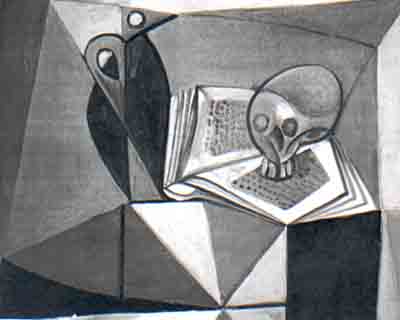
Picasso: Skull and book,
oil on canvas. 80 x 100cm, 1946
Fig.2)
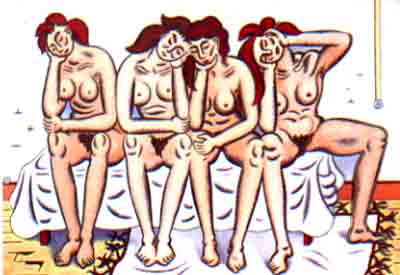
Helion: Four seated nudes, oil
on canvas. 114 x 162, 1949
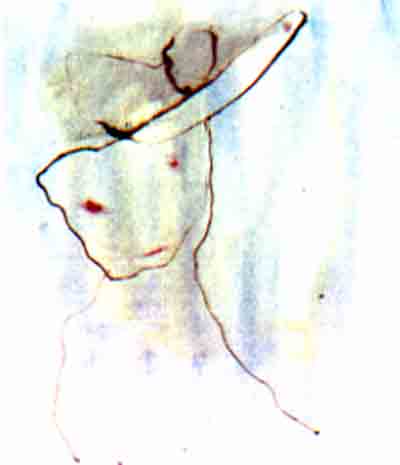
Michaux: Untitled, watercolur
on canvas. 38 x 28, 1947
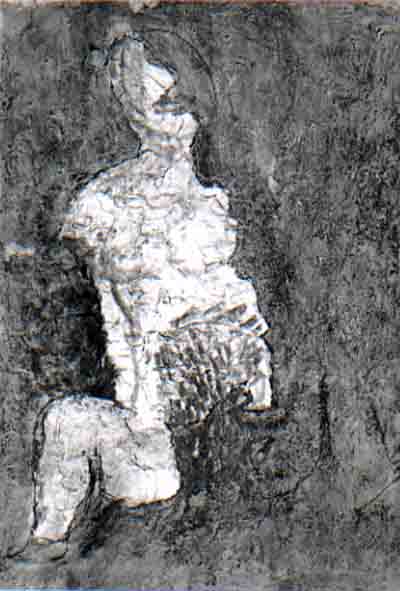
Fautrier: Sarah, 116x 89, 1942-
3
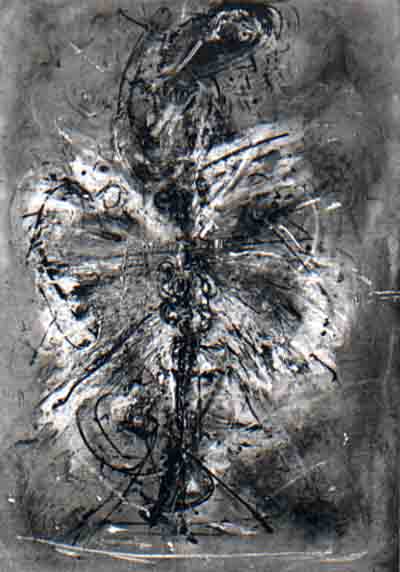
Wols: Bird, 92.1 x 65.1, 1949
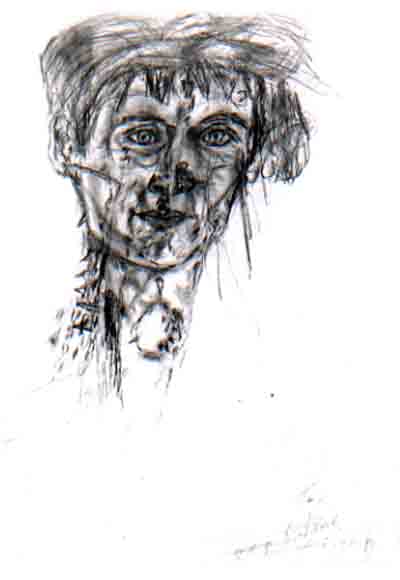
Artaud: Portrait of Henri Pichette
or Gris Gris, 64.7 x 49.8, 1947
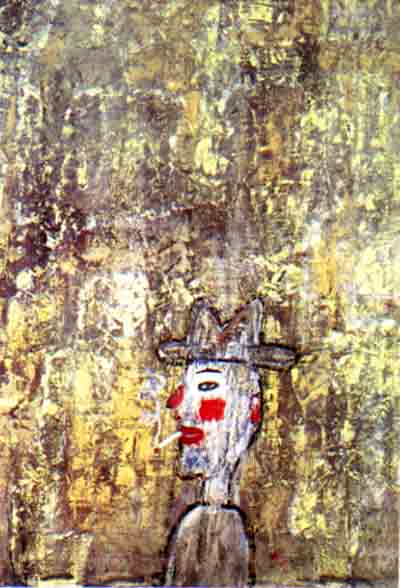
Dubuffet: Smoker by a wall, 116
x 89, 1945

Gruber: Nude in red waistcoat,
1944
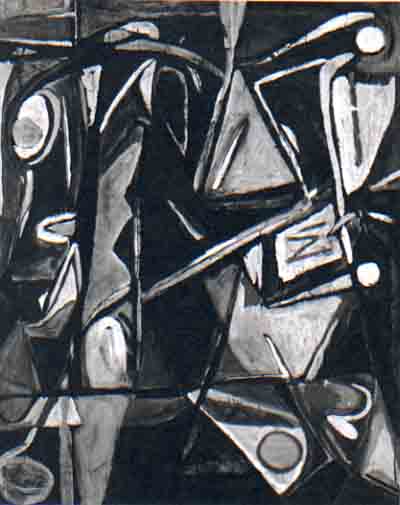
Velde: Untittled, Montrouge,
162 x 130, 1951

Giacometti: Diego seated, 1949
Fig.3)
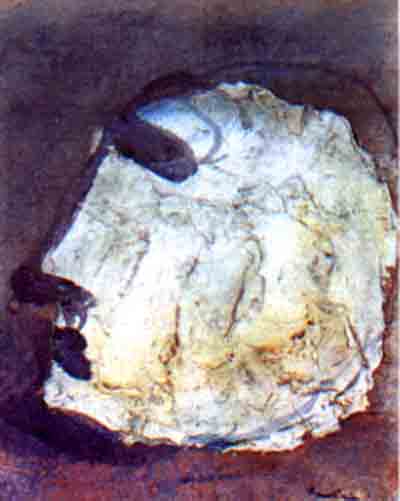
a) Fautrier: Head of a hostage,
28 x 22
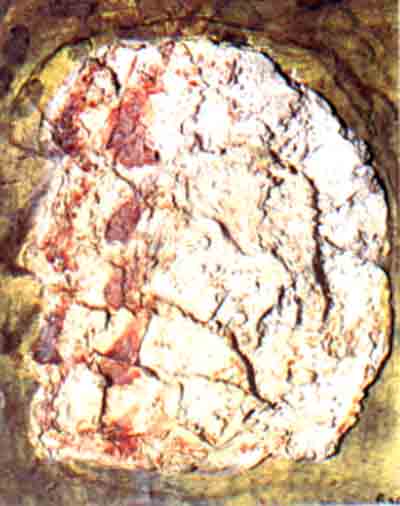
b) Fautrier: Head of a hostage,
35.6 x 26.7
Fig.4)

a) Dubuffet: Smoker by a wall,
116 x 889, 1945
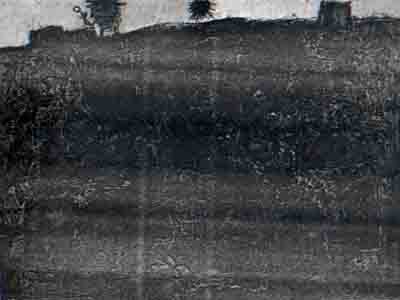
b) Dubuffet: The Geologist, 97
x 130, 1950
Fig.5)
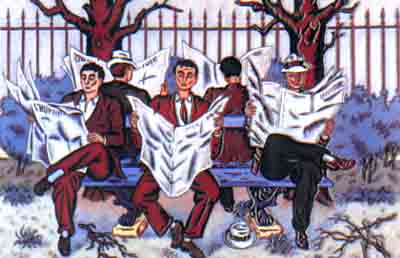
Helion: Men reading newspapers,
129.5 x195, 1950
Fig.6)
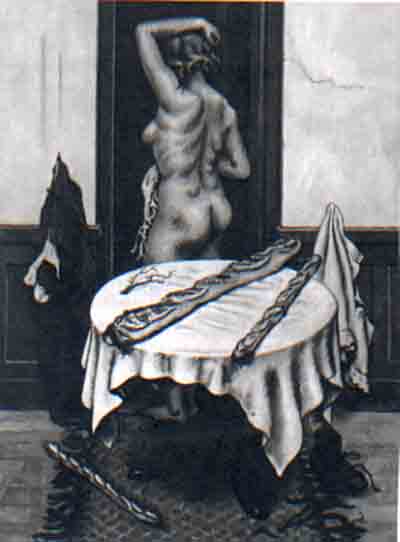
Helion: Nude with loaves, 130.1x
97, 1952
Fig.7)
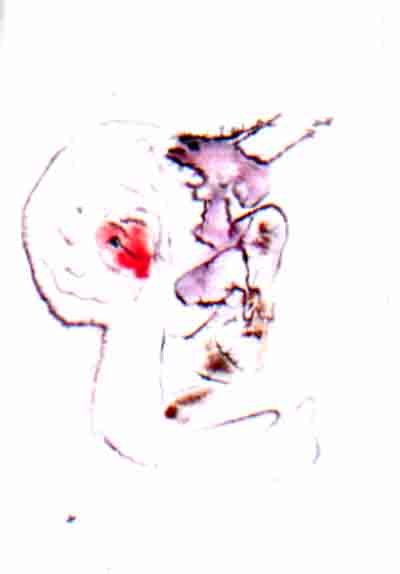
a) Michaux: Untitled, 39.1 x
29.2, 1948
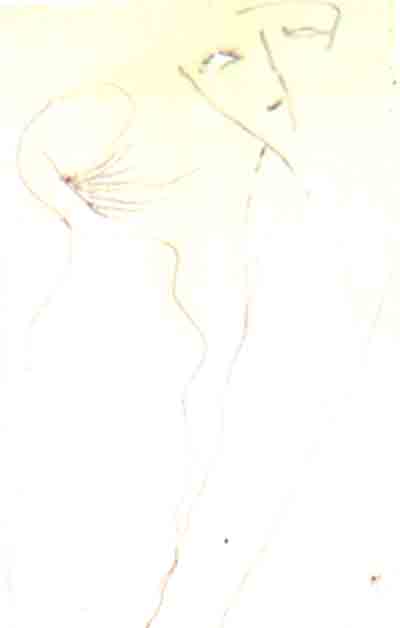
b) Michaux: Untitled, 46 x 30,
1947-8
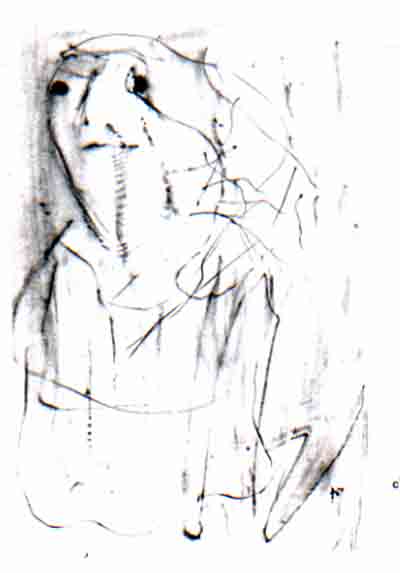
c)Michaux: Untitled, 50 x 32
Fig.8)
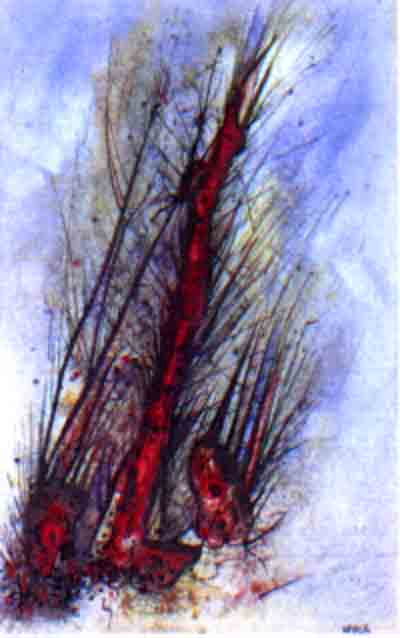
a) Wols: Branching tree stumps
in the wind, 18.7 x 10.5, 1944-5
.jpg)
b) Wols: Nearby star, (Our Earth)
20.4 x 12.2, 1944-5

c) Wols: The mad boar, 20.4 x
12.2, 1945
Fig.9)
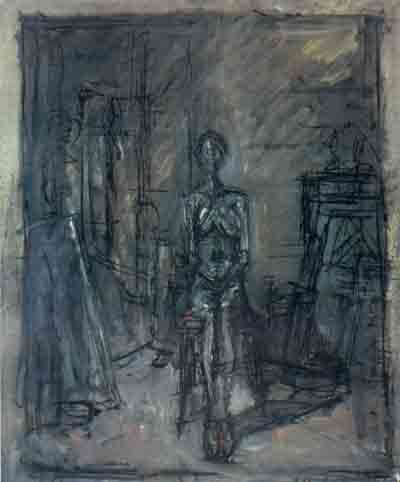
a) Giacometti: Figure study, 1953

b) Wols: Untitled, 18.7 x 33.3,
1944-5
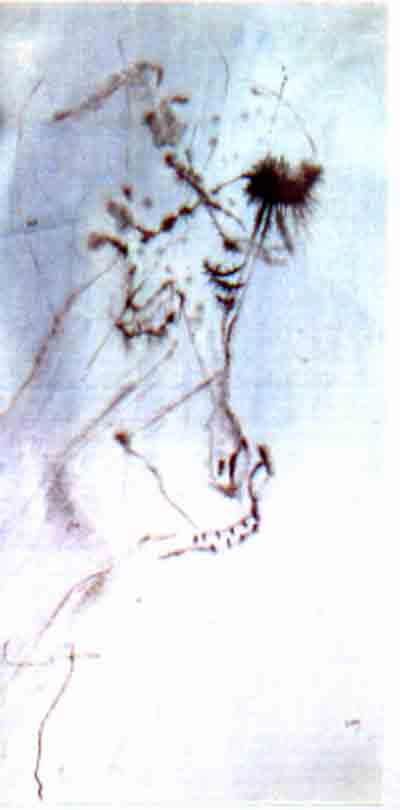
c) Michaux: Untitled, 40x 29.2,
1947
Fig.10)
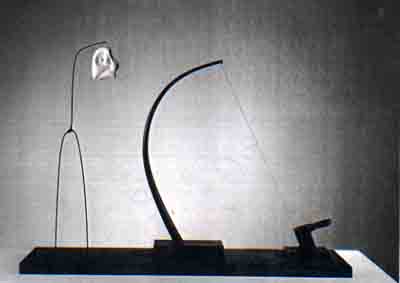
Giacometti: Flower in danger,
1933

Giacometti: Portrait of the artists
mother, 1947
Fig.11 )
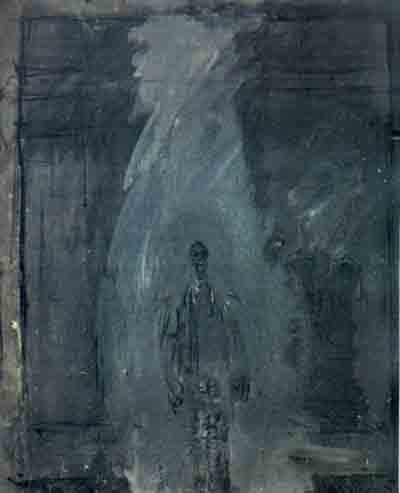
Giacometti: Standing man, 1957
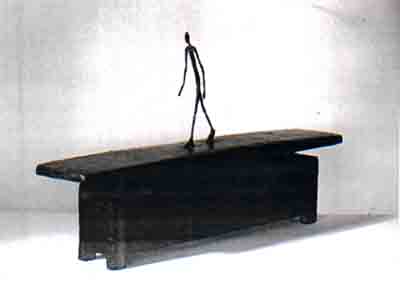
Giacometti: Man walking in rain,
1948
Fig.12)

Giacometti: Jean Genet, 1955
Fig.13)

Giacometti: Man pointing, 1947
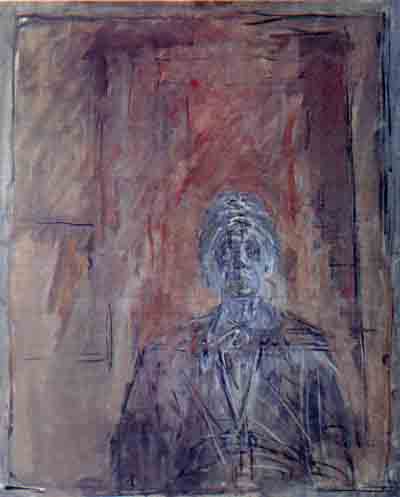
Giacometti: Portait of the artists
mother, 1958
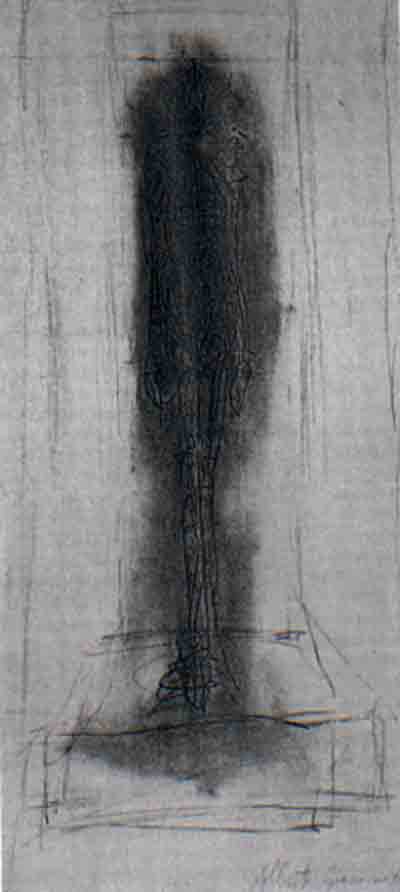
Giacometti: Standing nude, 1953
Fig.14)
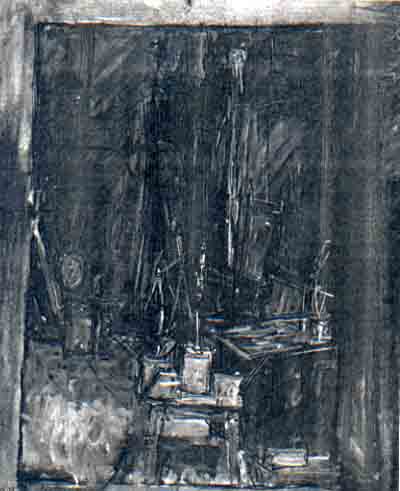
Giacometti: The studio with man
pointing, 1951
Fig.15)
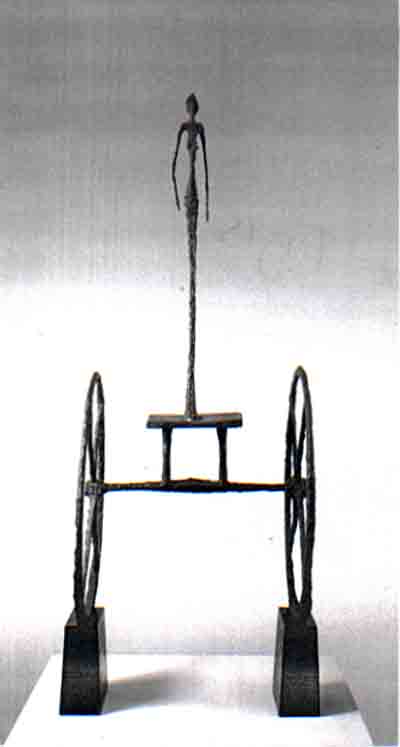
Giacometti: The chariot, 1950
Fig.16)
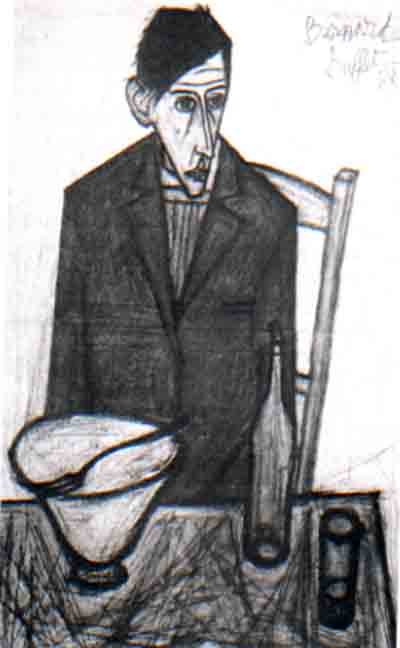
Buffet: Solitude, (The seated
drinker) 1948
Fig.17)
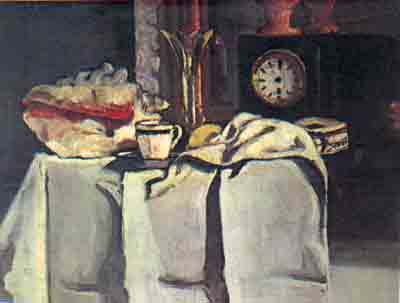
Cezanne: The black clock, 54 x
73, 1869-70
Fig.18)
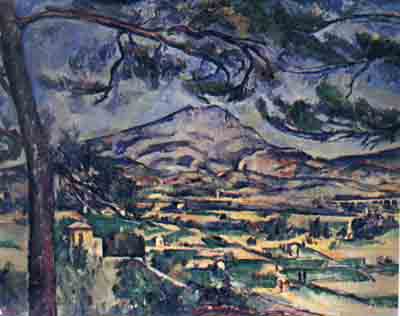
Cezanne: Mont ste victoire, 66
x 89.5, 1886-8
Fig.19)
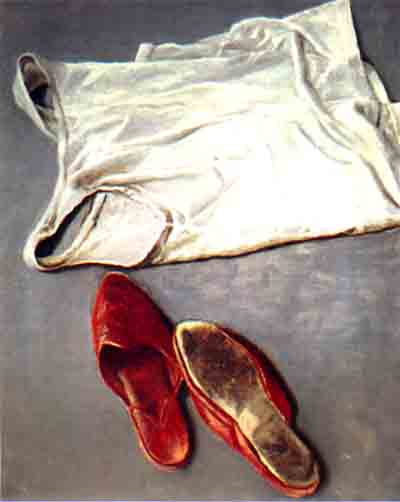
Arikha:Slippers and undershirt,
81 x 65, 1979
Fig.20)
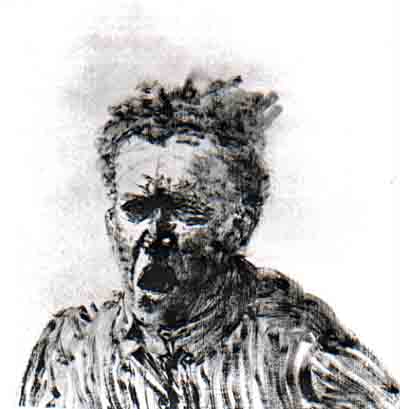
Arikha: Self portrait shouting
one morning, 46 x 38, brush and ink, 1969
Fig.21)
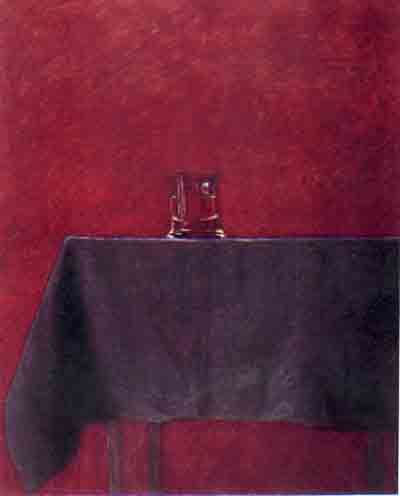
Arikha: Glass of whisky, 81 x
65,1974
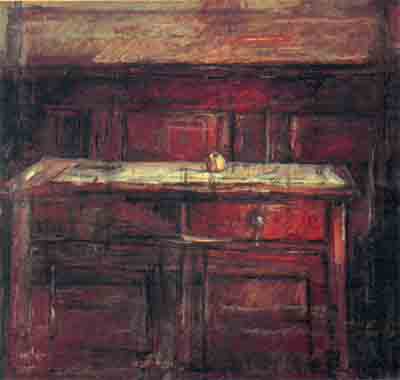
Giacometti: Apple on sideboard,
1937
|